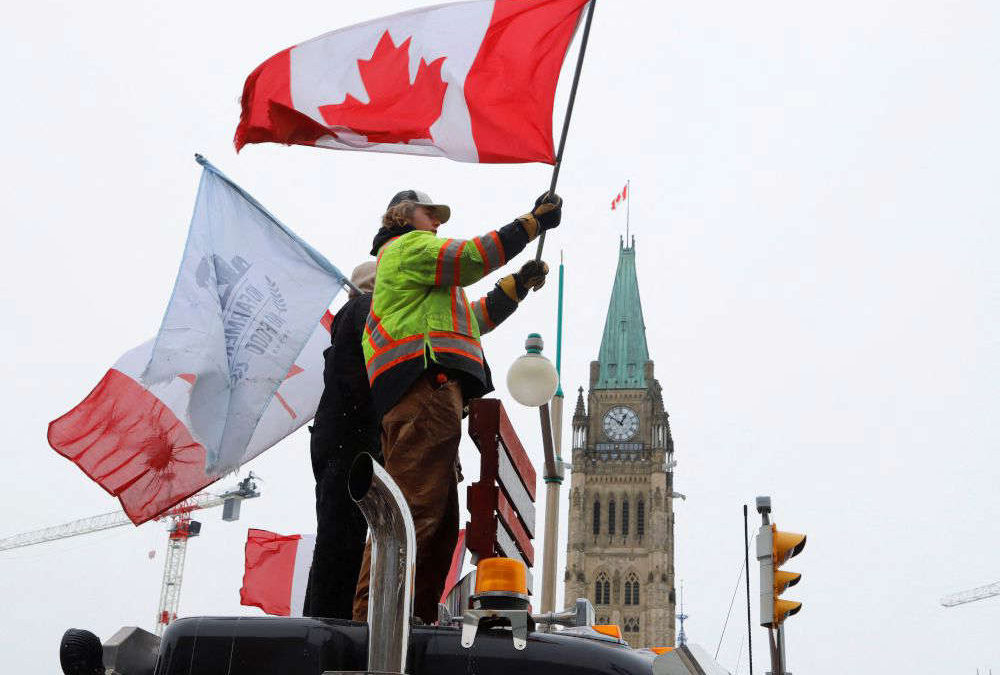Even at its height, the size of the protest, about 8,000 people, was a rounding error compared with the big demonstrations that often play out in Washington. But unlike their American counterparts, Canadians aren’t accustomed to sustained mass protests on the conservative side of the political spectrum — a phenomenon we’re now all primed to associate with extremely angry men wearing camouflage or horned fur hats. And so the Freedom Convoy set off a wave of social panic among Canadian progressives no less unhinged than protesters’ claims that the Great White North had become a police state.
Barricades of Canadian rail lines and oil-and-gas projects occur regularly in Canada, as do large rallies championing Black and Indigenous rights. But these liberal protests tend to attract highly sympathetic treatment from the media — unlike the Freedom Convoy, which was cast as suspect, and even dangerous, from the moment it started moving eastward. The anti-vaccine movement has no real mainstream political constituency in Canada, where more than 88 per cent of citizens older than four have received at least one dose. And once convoy participants arrived in Ottawa, none of their scattered bozo eruptions could be explained away as mere byproducts of righteous social justice fervour.
Not surprisingly, a national survey released Thursday indicated that a majority of respondents thought that the protesters’ actions were (in the oh-so-Canadian phrasing of the pollsters) “offensive and inappropriate.” And the longer the thing goes on, even in a vestigial capacity, the less popular it’s likely to get: one-off acts of protest are part of life in a democracy. The creation of lasting urban encampments that spew noise and diesel fumes is not.
There’s a certain tragic quality to the convoy, though, as it was never clear how the project would succeed politically, even theoretically. If this had been a similarly motivated American trucker convoy — say, one rolling toward D.C. from Utah and Colorado along Interstate 70 — the organizers might realistically hope to be greeted warmly by photo-opping elements of the Republican party, not to mention the glossy propaganda apparatus of Fox News. Even if nothing concrete were achieved, such a pageant would at least help mark off a sizable and very real power base within the GOP. But in Canada, that kind of faction simply doesn’t exist within mainstream electoral politics. Even those few Conservative party MPs who offered as much as a simple thumbs-up gesture on behalf of the convoy have generally backed off, on pain of being denounced as Nazi-adjacent by Canadian media.
For years now, democratic nations have been wrestling with what has been described as the “centrifugal forces of polarization and inequality” — with conservatives turning toward mob populism, while liberals are pressured to embrace esoteric theories of race and gender. In both respects, the United States, having given the world both Donald Trump and the “great awokening,” often is held out as the most shocking cautionary tale.
But the American political system was much better equipped to assimilate this centrifuge than Canada’s, since U.S. primary elections already had been acting for decades as a signal-booster for extremists on both sides. Canada’s political system is very different: At both the federal and provincial levels, parliamentary votes tend to be ruthlessly whipped by party leaders who exercise complete top-down control of their caucuses (until they’re ousted, that is). These same leaders also monopolize control of candidate lists in elections, and they rarely hesitate to turf any party member who becomes a public relations liability.
The result is that even though Canadian politics is conducted, for superficial public consumption, in a bizarrely apocalyptic vernacular adopted from America’s culture war, there actually isn’t that much space separating conservative and liberal politicians when it comes to important policy issues — which is why Ontario and Alberta, two large provinces run by conservative premiers, imposed stringent lockdown policies in response to the Omicron variant, and why both now boast of vaccination rates that barely diverge from the national average (which is itself much higher than that of the United States).
This is the best part of Canadian politics: Yes, we lose our minds on Twitter and Reddit like everyone else. But this is typically just symbolic blood sport. When it comes to real-life decision-making, the fundamentally centripetal mechanics of our system encourage us to act like adults. In the United States, almost 0.3 per cent of the population has died of COVID-19. In Canada, the corresponding figure is less than 0.1 per cent.
The downside is that the Canadian approach systematically alienates that small (but not insubstantial) portion of the population that doesn’t see itself represented, even symbolically, in electoral politics — except through the People’s Party of Canada, a 2018 conservative splinter party that won five per cent of the vote last year despite a concerted media effort to present it as a haven for bigots. In the United States, even the most radicalized wing nut can entertain some faint hope of pushing a fringe candidate through a primary, and maybe even into the House of Representatives. In buttoned-up Canada, where a candidate risks ejection from his party just for standing too close to a colleague or getting into an argument, that isn’t the case.
What’s worse (from a conservative’s point of view), the situation in Canada is fundamentally asymmetrical: while conservative populist sentiment is largely taboo within Canadian institutional politics and mainstream media, radicalized liberal dogmas are not only tolerated but performatively embraced.
This includes the doctrinaire formulations of American social justice activism that have been imported wholesale into the Canadian political space, both by Trudeau and Jagmeet Singh, leader of the left-wing New Democratic Party that’s propping up the Liberals’ minority government. In recent years especially, Canadians have been greeted by the spectacle of Trudeau, a serial blackface enthusiast in days of yore, taking a knee to Black Lives Matter and denouncing his own country as a genocide state. He also has demanded that his subordinates enact public policies “informed and developed through an intersectional lens, including applying frameworks such as Gender-based Analysis Plus (GBA Plus)” — which would strike most ordinary Canadians, probably including his own supporters, as pretentious faculty-lounge gibberish. And in 2020, when a mob tore down a statue of Canada’s first prime minister, Trudeau and other Canadian liberal leaders stared silently at their feet, a fact not lost on the truckers now being excoriated for every stray act of rudeness in Ottawa. You don’t have to be a trucker, or even a vaccine mandate opponent, to see this double standard as hypocritical.
As I write this, various Conservatives are marshalling their forces for a leadership run, with the winner to face off against Trudeau in the next election. Each faces the same single existential decision in regard to the brand of outlying conservative populism that announces itself with a horn: (a) let the outliers into the big tent, and watch the Conservatives be excoriated in the media as Canada’s answer to Trumpism; or (b) cast them out, and send them fleeing to the People’s party, which will then siphon off support on the Conservatives’ right flank.
There’s no right answer. But either way, these big rigs will find a place to park.
The Washington Post
( Edited by Michael/Carol Reviewed by Lucia )


